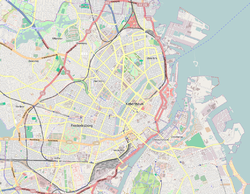| Rosenborg Castle | |
|---|---|
 Rosenborg Castle seen from the Castle Gardens | |
| General information | |
| Architectural style | Dutch Renaissance |
| Location | Copenhagen, Denmark |
| Coordinates | 55°41′8″N12°34′40″E / 55.68556°N 12.57778°E |
| Construction started | 1606 |
| Completed | 1624 |
| Client | Christian IV |
| Design and construction | |
| Architects | Hans van Steenwinckel the Younger, Bertel Lange |
Rosenborg Castle (Danish : Rosenborg Slot) is a renaissance castle in Copenhagen, Denmark. The castle was originally built as a country summerhouse in 1606 and is an example of Christian IV's many architectural projects. It was built in the Dutch Renaissance style, typical of Danish buildings during this period, and has been expanded several times, finally evolving into its present condition by the year 1624. Architects Bertel Lange and Hans van Steenwinckel the Younger are associated with the structural planning of the castle.












